Integration Of Local Cultural Heritage In Art and Design Teaching And Learning: Creative Outputs On Sarawak Native Cultures
This title (paper) has been presented at International Knowledge virtual Conference 2021 (IKC2021) organised by Pustaka Negeri Sarawak. The paper was prepared by Dr. Fiona Wong E Chiong and Pn. Bibi Zafirah Hanfa Badil Zaman from Fakultas Hukum Universitas Sriwijaya.
Contents
Abstract
Cultural heritage is essential and important to every nation in the world. Cultural heritage comprises physical artifacts and intangible attributes of a people or society passed down through generations. Cultural heritage provides an individual or community a sense of belonging and connects the generations through stories and past histories of the people.
This paper demonstrates the integration of local cultural heritage contents in art and design teaching and learning approaches at a higher tertiary level through courses in art history and visual communication (branding design). The significance and relevance of local cultural heritage are highlighted in the art and design assessment-based teaching and learning approaches that engender the understanding of cultural diversity and cultural tolerance.
This paper focuses on the Sarawak native cultural contexts incorporated into art and design assignments and projects which resulted in creative outputs and visual interpretations. The understanding of Sarawak native cultures is reinforced outside the classroom through implementation of study trips or field excursions to on-site locations, talks, demonstrations and workshops. Communication and interaction with the local peoples took place, added with research observations and visual analysis, eventually instigated new and interesting design ideas and concepts that are both creative and innovative reflective of the Sarawak native cultures in the final design outcome, as well as incorporating the usage of sustainable materials and methods of processes. Examples of creative outputs and visual interpretations of Sarawak native cultures mainly produced by art and design university students in these two courses will be cited in this paper.
Keywords: Sarawak native cultures, cultural heritage, art and design, teaching and learning, innovative designs
Background
This paper presents an overview of how local cultural heritage topics and contents are integrated in the teaching and learning approaches of art and design courses at a bachelor’s degree level of a private higher institution of learning in Malaysia. This paper will cite examples of the creative outputs in various forms of art, design and craft works by students as a result of such teaching and learning approaches. This paper discusses the relevance and benefits of such teaching and learning approaches to both the lecturer and student, as well as evaluate and review the outcomes and effectiveness of the methods. This paper looks at the Sarawak culture as being one of the country’s pertinent and significant local cultural heritage topics that are incorporated and integrated into the teaching contents as well as in the students’ assignment or project brief by both authors, relating to their own East Malaysian (Sarawak and Sabah) cultural heritage. This paper presents an alternative approach in art and design teaching and learning in hope to stimulate and encourage the interest and knowledge on Sarawak culture first, and subsequently on Sabah and other states in Malaysia.
Cultural heritage is essential and important to every nation in the world. Cultural heritage comprises physical artifacts and intangible attributes of a people or society passed down through generations. Cultural heritage provides an individual or community a sense of belonging and connects the generations through stories and past histories of the people. The rich cultural heritage of Sarawak forms the basis of this paper. The courses and students’ work examples cited in this paper are derived from the 3-year BA (Hons) Design Communication programme offered at the Department of Art, Design and Media, School of Arts, Sunway University. Among the many courses in this programme, two courses—History of Art and Design, and Visual Communication and Graphic Design—form the basis of the discussion in this paper.
a) History of Art and Design
History of Art and Design is a Year 1 course which is an important fundamental building block in establishing a good knowledge foundation base for the students by drawing references to other well-established examples of art and design in not only of the Western history, but also of some history from Asia and Southeast Asia, including Malaysia. The course investigates on the textual analysis and historical understanding of a subject matter in the context of contemporary art and design practice, encouraging students to use the analysis gained to develop an understanding of themselves and their work within their selected areas of interest. A high level of personal initiative and an inquisitive mind are expected of the student to meet the course’s learning outcomes[1]; the study should lead to self-awareness and realisation from a historical, contemporary and commercial perspective.
b) Visual Communication and Graphic Design
Visual Communication and Graphic Design is a Year 2 course which aims to develop the necessary skills for graphic design students to communicate their ideas across specialist applications both traditional and alternative. This course covers advance concepts and processes of graphic design and portfolio preparation, encouraging students to explore the creative process by combining traditional art and design media toward original design solutions and incorporating with advanced digital imaging and typography, packaging and digital contents for the present digital era. The course emphasizes on the relationship between individual creative and critical thinking skills and the designer’s roles with professional and cultural and historical contexts. Therefore, a state branding topic was introduced to the students and a project was assigned to them to investigate and analyse the context and characteristics of a particular state in Malaysia, as well as its essence and uniqueness. The design output of this project is expected of the students to meet the learning outcome[2] in this course.
Method
The teaching and learning method and strategy employed was a qualitative approach in both courses that encourages an in-depth understanding of Sarawak culture with an emphasis on exploring and analysing the context and various aspects surrounding the subject matter of study. Apart from in-class lectures and tutorials that introduce and discuss the ideas and key aspects of the subject matter, other teaching and learning methods and practices have been employed to stimulate interest and participation of students while learning about the subject matter, such as group discussions, literature research, visual analyses, brainstorming sessions, mind-mapping exercises, case studies, informal peer reviews, as well as outside classroom or off-campus activities, such as study trips or field excursions, site observations, talks, workshops and demonstrations.
The most anticipated and well-received teaching and learning approach for our students are the research-based study trips and visual analysis exercises that are embedded into the teaching plans to encourage students in their active exploration and maximise their five main sensory experiences to observe and absorb new sights, sounds, taste, smell and touch that interpret identities. Students’ findings, explorations and inspiration of ideas in their own interpretation of the context will be prompted and demonstrated in the creation of a final design project. The assignment or project that we designed are with the intended learning outcome of each course to determine a suitable project for students to work on and apply their knowledge gained and their own interpretation of the context.
a) Study Trips
i. Study Trip to Kuching, Sarawak
During the April-July 2019 academic semester, lecture topics on local cultures which included Sarawak culture were delivered to the students in class. In order to enhance the students’ learning even more, hence a study trip to Kuching, capital of Sarawak, was organized in May 2019 in order to let students know about the Sarawak culture first-hand. The students were immersed in the Sarawakian environment, they saw and experienced for themselves, as well as gained a deeper understanding and appreciation of Sarawak’s culture, people, food, clothing, traditions and heritage through on-site observations and casual interaction and conversations with the local people especially the indigenous ethnic Dayak community at the Sarawak Cultural Village in Santubong. This study trip took place on 26th to 28th August 2019, in conjunction with the Sarawak Harvest and Folklore Festival[3] that was held at the same time. A total of 16 students (comprising West Malaysians and foreign/international students) joined the study trip, guided and led by two lecturers who are the authors of this paper.
The study trip to Kuching was planned with the following objectives in mind:
- -Learn and experience in person Sarawak ethnic cultures, arts and crafts, architecture, history, heritage, traditions, folklores, foods
- -Witness and observe the various Dayak ethnic groups’ traditional cultural arts and crafts through demonstrations and workshops at the Sarawak Cultural Village
- -Analyse the various arts, designs and crafts as well as the places visited in Sarawak and apply the knowledge gained into own artwork
The programme itinerary of the study trip included the Sarawak Heritage Trail (mainly centred in Kuching south city) as well as the Sarawak Cultural Village in Santubong, a federal constituency of Kuching division. Other places of interest visited included the Sarawak Museum’s Natural History Museum and Art Museum, Sarawak Textile Museum, the Main Bazaar, Carpenter Street, Gambier Street, Tua Pek Kong Temple, Fort Margherita, the Astana, the Waterfront and the Cat Statues (Figures 1-4).
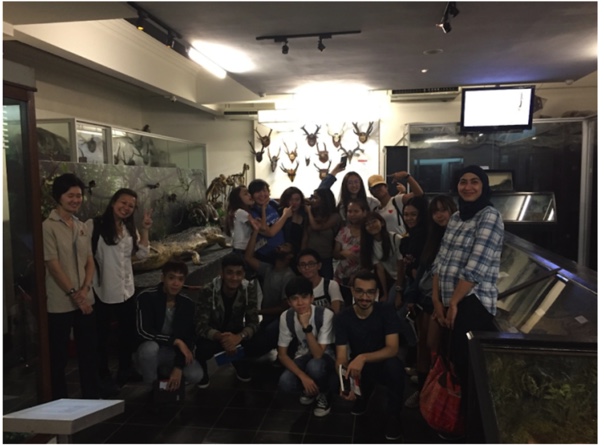
Figure 1. Visiting the Natural History Museum (under the Sarawak State Museum) in Kuching (Photograph by Fiona Wong, 2019)

Figure 2. Group photography in front of the famous huge Cat Statue in Kuching South City. This cat statue is often “dressed up” in different ethnic costumes following the various festivities and celebrations in Sarawak. (Photograph by Fiona Wong, 2019)
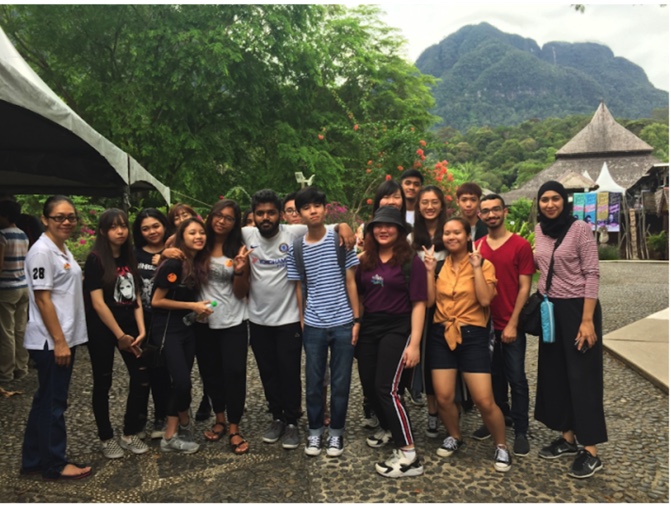
Figure 3. Group photography at the Sarawak Cultural Village in Santubong, posed against the backdrop of the legendary Santubong mountain. (Photograph by Fiona Wong, 2019)

Figure 4. Group photography with an Iban lady after demonstrating pua kumbu weaving at the Sarawak Cultural Village. (Photograph by Fiona Wong, 2019)
ii. Study Trip to Centre for Malaysian Indigenous Studies (CMIS) of Universiti Malaya, and Pasar Borneo in Seri Kembangan, Selangor
During the August-December 2019 academic semester, another study trip was arranged to learn about Sarawak culture, however, due to unforeseen circumstances and limitations, this time round the study trip took place within West Malaysia instead of having to travel to Sarawak, East Malaysia. One may be surprised to find that it is still possible to learn about certain aspects of Sarawak culture by visiting the Centre for Malaysian Indigenous Studies (CMIS) at the University of Malaya, and Pasar Borneo in Seri Kembangan, Selangor. In May 2019, a group of 24 students were brought on a study trip to visit CMIS and Pasar Borneo. At CMIS, the director of the centre, Dr Welyne Jehom, gave a talk to students about the ethnic groups in Sarawak, and showed the students an assortment of appealing and intricate crafts work ranging from weaved textiles, bags, baskets, hats; beaded bracelets and jewellery; craved works of sorts. Dr Welyne also gave a talk about the Iban’s pua kumbu (Figures 5 & 6).
The next destination was Pasar Borneo, a pasar pagi or morning market that exists in only a short stretch of a street with two aligned rows of stalls fronting each other, and only ‘opens’ and operates on every Saturday morning in Seri Kembangan, Selangor. Pasar Borneo, led by Persatuan Pasar Budaya Borneo, is an open-air market comprising mainly Sarawakian and Sabahan vendors and sellers of goods, foods and crafts that were self-produced or imported from Sarawak and Sabah (Figures 7 & 8). Besides, there are also different ethnic women dressed up in their traditional costumes, parading and flaunting their appealing designs.
These study trips benefitted the students not only in their learning and experiencing local traditional and cultural arts and crafts, places, foods and people of Sarawak, but also promoted their understanding, critical thinking, awareness and appreciation of a local traditional and cultural heritage and visual culture. Through these study trips, students were inspired to innovate and generate their own creative design output by interpreting their understanding of the Sarawakian art, design or craft work.

Figure 5. Group photography with Dr Welyne Jehom in front of a thatched stage in an open space o the CMIS building. (Photograph by Fiona Wong, 2019)
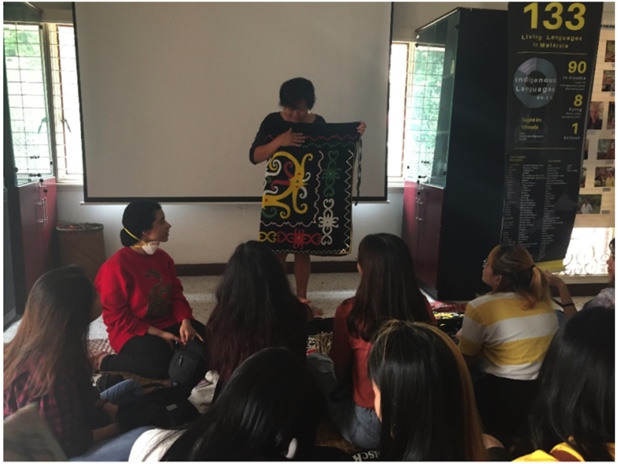
Figure 6. Dr Welyne Jehom gave a talk and showed the students an Orang Ulu beaded textile at CMIS, University of Malaya. (Photograph by Fiona Wong, 2019)
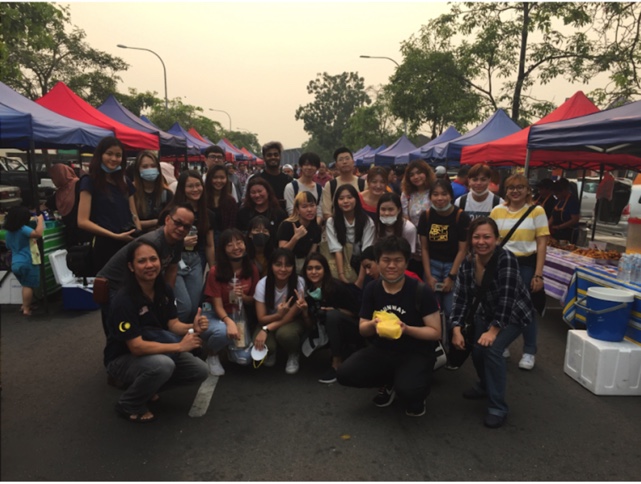
Figure 7. Group photography at Pasar Borneo in Seri Kembangan, Selangor (Photograph by Fiona Wong, 2019)
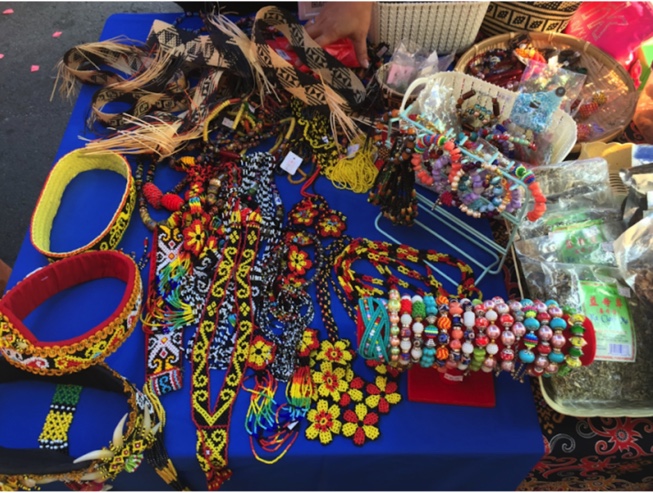
Figure 8. A colourful assortment of craft work of Sarawak displaying beaded jewellery and accessories, as well as woven bags or pouches. (Photograph by Fiona Wong, 2019)
b) Observations and Analysis
The students were exposed to numerous ways on collecting data during their study trip to Kuching, with the main aim which is to enable them to talk and observe the native in their natural habitat. The students were brought to the Natural History Museum (under the Sarawak State Museum) and witnessed for themselves the vast taxidermist and well-preserved collections of the various types of animal or insect species discovered and preserved since Rajah Charles Brooke’s time[4]. The students also visited the Art Museum (under the Sarawak Museum) where a fine display of Sarawak’s history were exhibited and enhanced with some state-of-the-art digital media such as sensorial, interactive and projected animation. At the Sarawak National Textile Museum, the students gained an understanding of the textiles and patterns produced by the native communities of Sarawak. After going through the information that they have gathered from the museums and having understood a little about the history background of Sarawak, students began to analyze the information in a critical manner and prepared a series of questions to ask for more information from the locals or experts.
At the Sarawak Cultural Village (also known as “The Living Museum”), the students gained more knowledge on how the native people live their daily lives, from cooking, clothing, carving to music and architecture. In conjunction with the Sarawak Harvest and Folklore Festival, the students were fortunate to have witnessed and experienced the vernacular architecture of the various Dayak ethnic groups, such as the Iban, Bidayuh, Orang Ulu. They observed the different architectural design and features by walking through the built structures in various shapes, sizes and length and constructed in wood and thatched leaves. The students also were being presented with a cultural performance in the small theatre hall, with beautiful dancers and talented performers representing the multi-ethnic and colourful Sarawak culture and people. The most exciting performances were a performer dressed as an Iban warrior demonstrating his blowpipe shooting skill, and another performer balancing on top of the long pole held upright vertically in a dance. Apart from the mesmerising performance, the students experienced four different art and craft workshops and demonstrations (that were pre-arranged as part of the study trip itinerary). These included the Iban hand-tapped tattooing and pua kumbu weaving demonstration, Orang Ulu bamboo-carving and Bidayuh beads-threading workshops. Another highlight was the students learning and experiencing cooking ayam pansoh in bamboo guided by an Iban mentor, after which the students had their cooked ayam pansoh for their lunch. The students collected some valuable information of the native communities in Sarawak by interacting and talking to the local Dayak people. From here they could understand and visualize how the native Dayak people live day by day. Students also interviewed informally an Iban tattoo artist who gave them some insights into the meaning of the motif or pattern and how it evolves with each individual personality and achievement in life. Students are also able to see and learn from a demonstration how the traditional hand-tapped tattoo is done on the body.
All these translated to valuable first-hand experiences for the students, the students would record them down by means of photography, video recording or observation sketching, and later analyzed and dissected from the core. Once all these data had been analyzed and the findings devised, students then began to interpret into ideas that inspired their designs and creation to relate to what the intended audience could grasp, understand and appreciate, although simplified or modernized into a more contemporary appeal, the original idea, essence and meaning remained.
In addition, the students also did observational studies at a few spots of the Heritage Trail at Kuching South City, including the Main Bazaar, Carpenter Street, and Gambier Street where they witnessed some traditional Chinese temples including the famous Tua Pek Kong and a Muslim mosque, apart from rows of old double-storey shophouses that consists of some traditional professions such as the glass or mirror maker and aluminium tin maker. They also tried local food delicacies such as laksa, kolo mee, bak so and kek lapis. Students also strolled along the famous Waterfront, bypassing the Fort Margherita and seeing the Astana located across river. The students also experienced taking a short 20-minute boat ride “across river” and back in small sampans with traditional designs.
Results
Students were exposed to numerous ways on collecting their data, the main goal is to enable them to talk to the local Sarawak people and observe the natives in their natural habitat. Students were brought to the Sarawak National Museum and Sarawak National Textile Museum to understand and collect valuable information of the history and background of the native and ethnic communities in Sarawak, as well as learning about the textiles used by these people. After going through the information that they have gathered in the museums, students would have to analyze the information in a critical manner and prepare a series of questions to ask for more information to the local and the expert. Students visited Sarawak Cultural Village, to gain more experience on how the native people goes through their daily life, from cooking, carving, musical instrument, performance, and joining a workshop that teaches students on how to create a simple but intricate beading. From here they can understand and are able to simulate, how the native people live day by day. Students also interviewed the tattoo artist, which gave them a lot of insight on the meaning or how the pattern evolve with each individual personality and their achievement in life. Students are also able to see and learn, how the traditional tattoo tap are done on the body. All of this is an important experience, that is valuable to the students, because every single emotion that the students go through, it will need to be recorded down, and be dissect to the very core. Once all the data have been collected and analyze, students began to interpret the meaning of each information and relating it back to a form that the intended audience are able to grasp, understand and appreciate. To attract and intrigue target audience, visual element from the main source will be simplified or modernize, but it will still carry the essence of the state or the main intended message.
The Assignment/Project Brief
1) "History of Art and Design Final Project “Sarawak: A Cultural Mosaic”
This final project titled “Sarawak: A Cultural Mosaic” was briefed to the students before the research-based study trip. The students are expected to conduct a preliminary research and gather information on a particular art, design or craft in Sarawak from various sources (such as books, internet, journals, exhibitions etc.) before their on-site visit and observations during the Study Trip to Kuching. By the end of the project, the students will be assessed based on their creative outputs and their level of understanding and re-interpretation of the contexts, as well as creativity, innovation and originality.
Each student will select and research on a preferred art, design or craft from Sarawak’s cultural mosaic and diverse ethnicities, as well as draw reference to its cultural heritage and tradition particularly in the arts and crafts. The student will analyze, interpret and create a new piece of “wearable art”, replicating and emulating as closely as possible the selected original Sarawak art and craft, taking into consideration every detail and element observed, applying them appropriately to the final artwork. Students will then devise a theme or concept that addresses an interesting aspect of the chosen art, design or craft, re-interpret the context creatively using an appropriate medium, material and technique. The final artwork could range from a painting to a sculpture, a fashion piece or an installation work to the viewer and audience. Students were prompted to produce visual analysis and idea sketches and compile the entire design development process into a workbook, which contains everything from research and analysis to the ideation, the exploration of various media, materials and techniques, and finally producing a different interpretation of a Sarawakian art, design and craft work.
As a result from the study trips, with further research and analysis on Sarawak culture from various sources online and publications from local libraries, the students creatively produced various kind of art or craft works ranging from wood craft, embroidery, jewellery-making, pottery to shoes painting, and so on. One of the most impressive and notable artworks produced by these students is a sape wood work that was entirely designed, crafted and tuned by a local student Toh Yi Xuen from Johor. With her background in the Chinese string instrument pi pa (琵琶) since her secondary school years, she is equipped with the knowledge and interest to research and explore making of a sape emulating the traditional sape instrument of the Orang Ulu in Sarawak. She had gained inspiration and drew references from online sources and consulted a music (and film) lecturer who has a background in string instruments and also owned a sape which he bought years back. Yi Xuen then embarked on a very challenging journey of making and crafting a sape of her own with some carpentry assistance from her father, experimented and developed her own version and interpretation of a sape-like instrument with actual frets installed and strings tied and tuned (Toh Yi Xuen’s workbook, 2019). Yi Xuen successfully produced a sape-like wood craft that displays curved and flowing patterns resembling those by the Orang Ulu and consideration to the hollow back that enables it to function almost like a real sape when the strings are plucked and resonate (Figure 9).
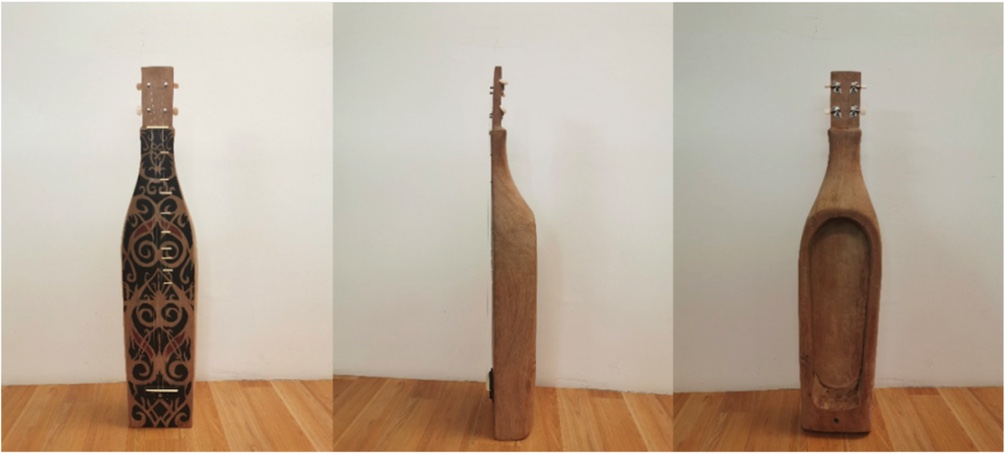
Figure 9. The frontal, side and back view of a sape instrument wood work entirely designed, crafted and tuned by student Toh Yi Xuen (Sunway University Teaching Archives, 2019).
Another impressive craft work is a pair of beaded earrings resembling the Marek Empang of the Iban culture designed and crafted by student Aishath Insha Abbas, an international student from the Maldives. Marek Empang is a piece of beadwork accessory that is worn by traditional Iban maidens during traditional dances and ceremonies, displaying patterns that represent the Iban motifs of animal spirits, which symbolises the connection to spirits that offer guidance and protection to the wearer. This particular motif designed and crafted in this pair of Marek Empang inspired earrings carry the spider motif, which are to the Iban people, a portrayal on the cloths as a means of protection from harm. The red, yellow and black coloured beads were sourced online and were delicately threaded using fishing strings. The beading style used is known as Brick Stitch beading and the colours—black, white, red, and yellow—used are the common traditional colours used by the Iban people (Aishath Insha Abbas’ workbook, 2019). The striking colourful motifs on this large-sized earrings with hoops are a bold fashion statement with a contemporary appeal to the present generation, showing a fresh interpretation of a traditional and cultural concept being adapted in present-day fashion (Figure 10).
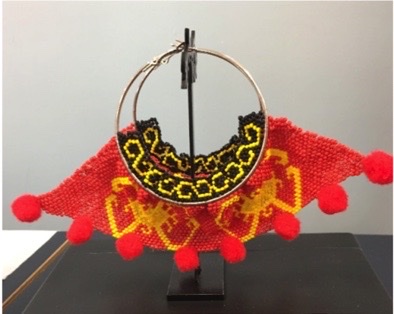
Figure 10. A pair of Marek Empang inspired beaded earrings entirely designed and crafted by student Aishath Insha Abbas (Sunway University Teaching Archives, 2019).
An intriguing work using sustainable materials such as newspapers is seen in this craft work entirely designed and crafted by a local student, Chan Jing Ning. Inspired by the Bidayuh’s hat known as trinak or tukuo worn by the Bidayuh women, Jing Ning decided to propose her own interpretation of a hat design using a more sustainable and recyclable material in particular the printed newspapers. She rolled up pieces of newspapers into long thin strips, and started weaving into a hat with her basic skills in weaving since her secondary studies. She had resorted to using the newspaper material as she did not manage to source for the rattan material which was the basic material of the Bidayuh’s trinak or tukuo. Jing Ning decided to employ only the popular and traditional red colour into the hat design, which she drew and painted by hand onto pieces of canvas cloth later attached and interweaved into the hat design (Chan Jing Ning’s workbook, 2019). The final outcome of her craft was pleasantly appealing and striking in shape and colours, the best thing is, it is made entirely of only newspapers! (Figure 11)

Figure 11. A hand-crafted hat inspired by the Bidayuh’s trinak or tukuo made up entirely of rolled up newspapers which are weaved into the shape of a hat and interlaced with hand-coloured motifs and patterns, originally designed and crafted by student Chan Jing Ning (Sunway University Teaching Archives, 2019).
An interesting observation and interpretation of a local food delicacy, Sarawak’s famous kek lapis or layered cake, is interpreted and designed into a set of three different designs of kek lapis stationery pouch by student Nur Nadirah binti Mohd Mustapa. Nadirah was inspired by the kek lapis which she tasted for her first time during the Kuching study trip, and she was mesmerized by the colourful designs of the kek lapis, with interweaved delectable layers and assortment of flavours and tastes. She then undertook the research and understanding the ingredients and processes of making kek lapis, also analysing their colours and patterns. Nadirah first painted her desired water-coloured drawings of three different kek lapis designs, then used sublimation transfer paper and the sublimation printing method (a type of transfer printing method using both heat and pressure that transfer an artwork onto a textile or garment), successfully printing her drawings onto a cotton cloth. She then used the sewing machine and sewed into a pouch shape and installed zippers onto them. The final crafted outcome portrays three different kek lapis inspired stationery pouches, which could also be used for other purposes such as to store toiletries or make-up items (Nur Nadirah binti Mohd Mustapa’s workbook, 2019). In addition, the kek lapis pouches tends to resemble real kek lapis when displayed next to each other on a surface (Figure 12).
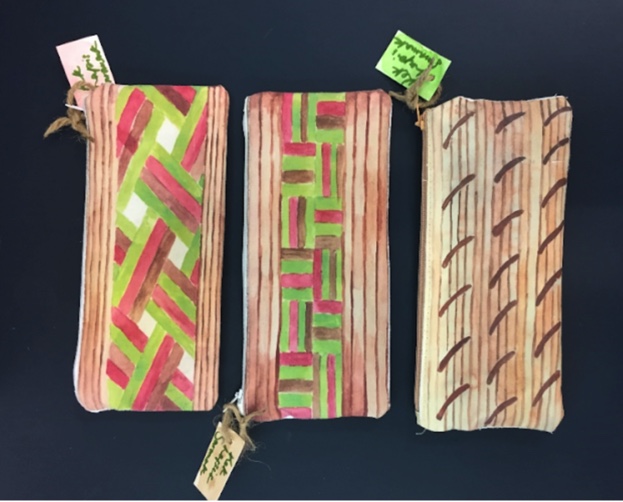
Figure 12. Three different kek lapis stationery pouches designed and crafted by student Nur Nadrah binti Mohd Mustapa (Sunway University Teaching Archives, 2019).
2. Visual Communication and Graphic Design Final Project on “State Branding”
Branding is an important aspect in every product or service, Branding is about telling a story and hinting the audience of the characteristic of a product or service that is offered. When it comes to state branding, the intended audience must be informed of the essence and uniqueness of the state.
Sarawak is rich with a variety of essence from food and delicacies, ethnic groups, natural resources, textiles to their beliefs. All these factors can be used to elevate the tourism sector or even other sectors such as education and investment. A way of doing this is by creating a distinct visual identity that can set Sarawak apart from other states or “competitors” and stand out to be unique and different in both the local and foreign markets.
In the logo design work of an international student Kyrie Newn Hui Lin from Brunei, the main essence of Sarawak culture is obviously embedded in the logo, but with a simplified and modern twist to it (Figure 13). There are three main essences combined into the logo, which are the culture, wildlife, and tattoo art – all these are elements and characteristics of the Sarawak culture
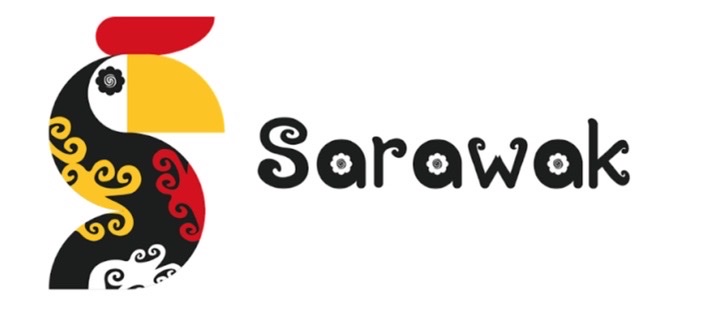
Figure 13. Logo design by student Kyrie Newn Hui Lin (Sunway University Teaching Archives, 2020)
Each student has a distinct style of design that they would highlight in the visual branding mainly for the intended target audience. Based on another local student Yap Ying Hui’s work (Figures 14-16), it mainly focused on how the various ethnic group coexist with each other harmoniously in Sarawak. The vibrant colors that have been applied as the visual elements are to pique the interest of the primary target audience, young adult and adult alike, between 18 to 30 years of age. Each icon on the logo and visual element has its own interpretation: the circle symbolizes the cohesive living nature in Sarawak among the ethnic group, while the flower is a common motif used in textile and also represents elegance and beauty. As for the pinwheel design, each flap represents the main ethnic group such as Iban, Orang Ulu, Melanau and Bidayuh; the diamond symbolizes the appeal and sparkle of each culture and each ethnic group has to offer. The design is broken down to the very essence of the meaning behind what Sarawak stands for, at the same time it created a much more contemporary design appeal that resonates with the intended audience much better and lures the audience in and discover the hidden jewel within Sarawak.

Figure 14. Logo design by student Yap Ying Hui (Sunway University Teaching Archives, 2020)
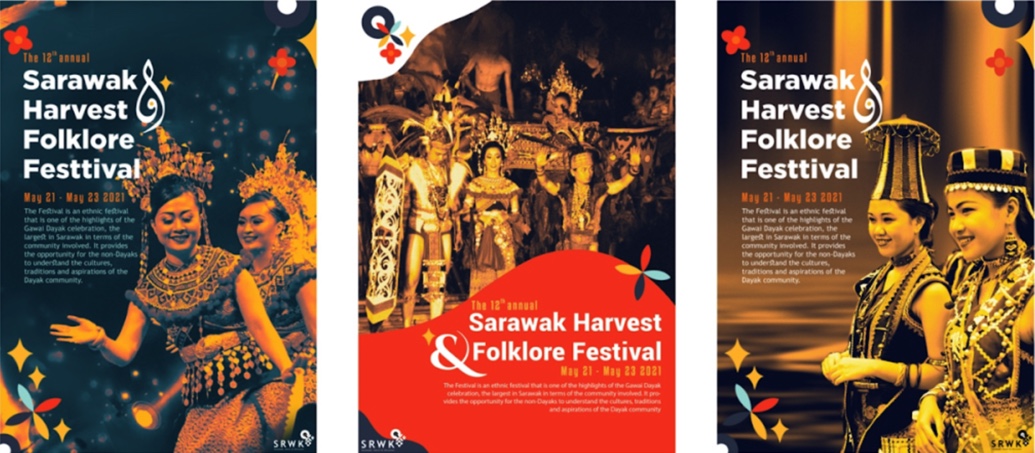
Figure 15. Application of the state branding in design collateral by student Yap Ying Hui (Sunway University Teaching Archives, 2020)
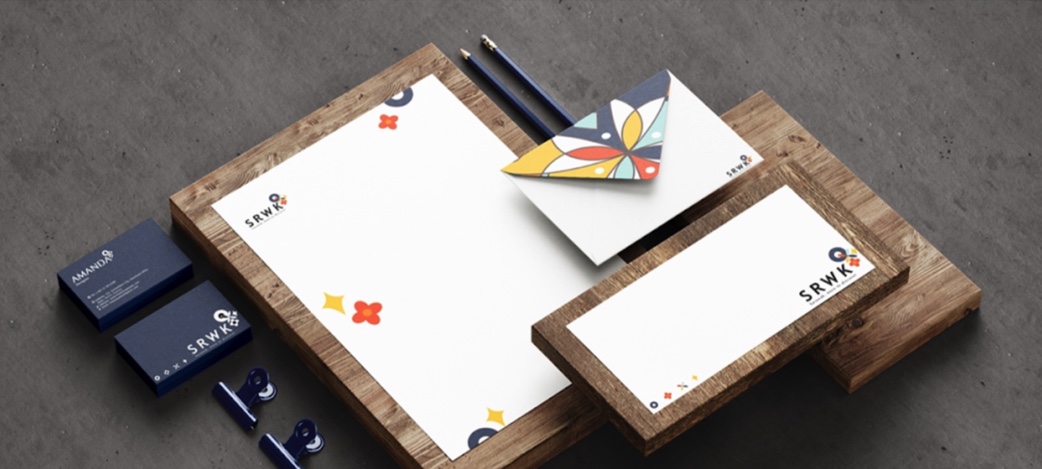
Figure 16. Stationery designs by student Yap Ying Hui (Sunway University Teaching Archives, 2020)
As for local student Elysa Jikos Gidiman from Sabah, she has intended the visual identity designs for Generation Z so they could learn and immerse with the cosmological beliefs that Sarawak has to offer. The Dayak communities have an intriguing belief of the afterlife, which would intrigue and appeal to the younger generation, comprising young adults and adults age between 16 and 35 years of age. In her approach, a story book idea was proposed as the design concept to unravel the cosmological beliefs of the native people in Sarawak. Her design idea was a different and interesting approach to be explored, as there is potential to attract a broader market both local and international and unravel the beauty of Sarawak’s culture. In her range of design outputs (Figure 17), the logo she designed uses two main colors – dark green and mustard yellow. Dark green represents the lush nature, while mustard yellow symbolizes the state itself and the treasure within the lush nature. The intricate line art is intended to show the talented craftmanship of the Sarawak native people. In the design collateral, “this is where all the magical stories unfold and reveal” are applied for the intended audience, therefore the designs look more intricate and richer with vibrant colors, and even the illustration style shows a more organic and freeform application to resemble the lush tropical and nature environment of Sarawak. Elysa also produced fully illustrated posters that are filled with everything that makes Sarawak what it is today with a modern feel to it and for her intended audience (Figure 18). Elysa managed to successfully unravel the rich story of Sarawak using her illustrations alone.
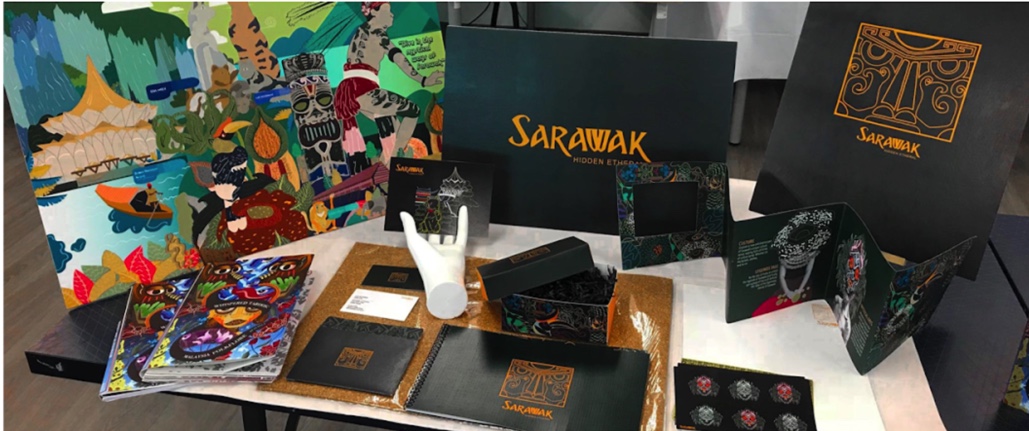
Figure 17. A set of design collateral for Sarawak by student Elysa Jikos Gidiman (Sunway University Teaching Archives 2020)
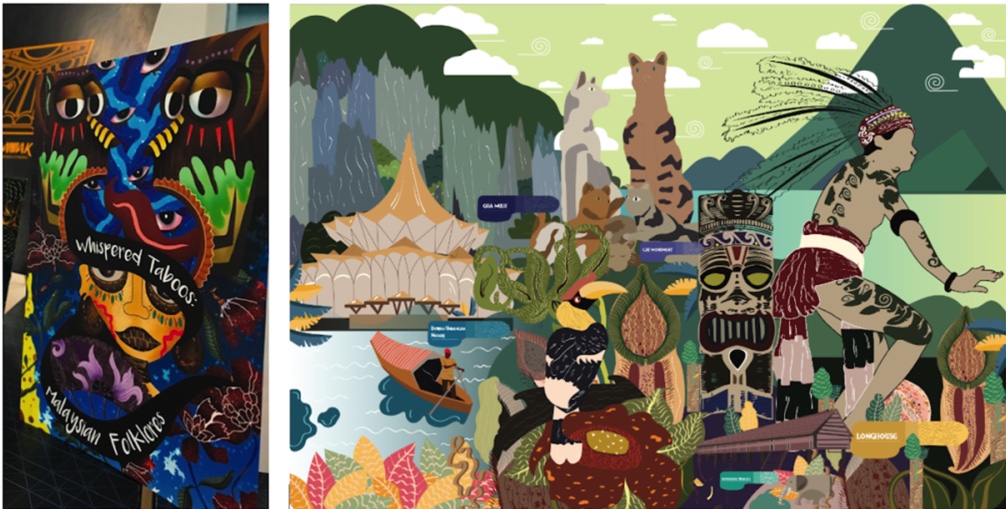
Figure 18. Illustrated posters artwork by student Elysa Jikos Gidiman (Sunway University Teaching Archives, 2020)
By integrating local cultural heritage into the assignment or final project as well as actual sites that are within reach filled with rich cultures and histories, the students had discovered their learning experience to be an eye-opener and a very interesting and exciting journey in understanding the Sarawak culture. The students were able to gather and collect valuable first-hand information in the study trips as well as used various methods of research in collecting their data. They were able to immerse themselves in the actual sites witnessing the local living and asked critical questions that made them more aware of Sarawak’s cultural attributes. They also learned about the symbolisms and meanings behind the cultural elements and learnt not to apply these elements “blindly” in their own design work; they have learned to respect and appreciate the culture. The students then analyzed the information gathered which enabled them to go more in depth understanding a specific cultural aspect, subsequently translating and interpreting in a practical and appealing design which could be understood and accepted by the target audience. Students also explored and experimented with various sustainable or practical materials, mediums and techniques in the process of their design or craft. The creative and innovative final outcomes had potential at a commercial level and brought about a positive impact and results. Ultimately, through this learning journey, the students gained a deeper understanding and knowledge of local cultures, as well as reflected on the importance of preservation and conservation of our intangible and tangible cultural heritage by their generation and future generations that follow.
Conclusion
This paper shows the effectiveness of integrating local cultural heritage contents such as that of Sarawak native cultures into the teaching and learning of art and design history, visual communication and graphic design. The various creative and innovative design outcomes produced by undergraduates in their assignments and projects reflect the designer’s understanding of the contexts, meaning and representation, subsequently applying and interpreting them into visual outcomes. The various creative outputs and visual interpretations also demonstrate the designer’s creativity and innovativeness in utilizing sustainable materials, techniques and processes, with varied styles and expressions, emulating the real native art and designs while still being relevant to the present modern-day society. This is perhaps an alternative means to educate our generations and preserve our local cultural heritage in ensuring its continuity and relevance in the future.
References
(Teaching Archives)
- Dr. Fiona Wong E Chiong. (2019). History of Art and Design Teaching Archives. BA (Hons) Design Communication programme, Department of Art, Media and Design, School of Arts, Sunway University.
- Pn. Bibi Zafirah Hanfa Badil Zaman. (2020). Visual Communication and Graphic Design Teaching Archives. BA (Hons) Design Communication programme, Department of Art, Media and Design, School of Arts, Sunway University.
(Project Workbooks)
- Aishath Insha Abbas, History of Art and Design workbook, Sunway University, 2019.
- Elysa Jikos Gidiman. (2020), Visual Communication and Graphic Design workbook, Sunway University.
- Chan Jing Ning. (2019). History of Art and Design workbook, Sunway University.
- Kyrie Newn Hui Lin. (2020). Visual Communication and Graphic Design workbook, Sunway University, 2020.
- Nur Nadirah binti Mohd Mustapa. (2019). History of Art and Design workbook, Sunway University.
- Toh Yi Xuen. (2019). History of Art and Design workbook, Sunway University.
- Yap Ying Hui (2020). Visual Communication and Graphic Design workbook, Sunway University.
Notes
- ↑ The course learning outcomes of History of Art and Design course are: Analyse textual and visual sources and apply these in the context of own work; Identify the historical, cultural, social and economic factors that influenced modern design; Recognize and record influential factors and their impact on creative and aesthetic evolution; Evaluate the creative output and visual interpretation as well as the accurate portrayal of subject contents and reflection of the contexts, which impacts on own practice.
- ↑ The course learning outcomes of Visual Communication and Graphic Design are: Analyse research, develop concept and visual planning strategies toward creative solutions for design problems; Transfer the ability to create visual hierarchy within the context of the designer’s grid; Apply formal design principles, colour theory and creative typography in design works; Evaluate one’s own work and peers’ work with critical analysis and constructive comments.
- ↑ The Sarawak Harvest and Folklore Festival is an annual festival held as a highlight of Sarawak’s significant Gawai Dayak harvest festival and celebration. This ethnic festival provides an opportunity for non-Dayaks to understand the cultures, traditions and aspirations of the Dayak communities. It was the 12th year running in the year 2019.
- ↑ The students were unable to visit the Sarawak Museum main complex which was going through a renovation at that time, which has today resulted in a newly built museum complex said to be the largest in Malaysia and second largest in Southeast Asia now completed and ready to launch.